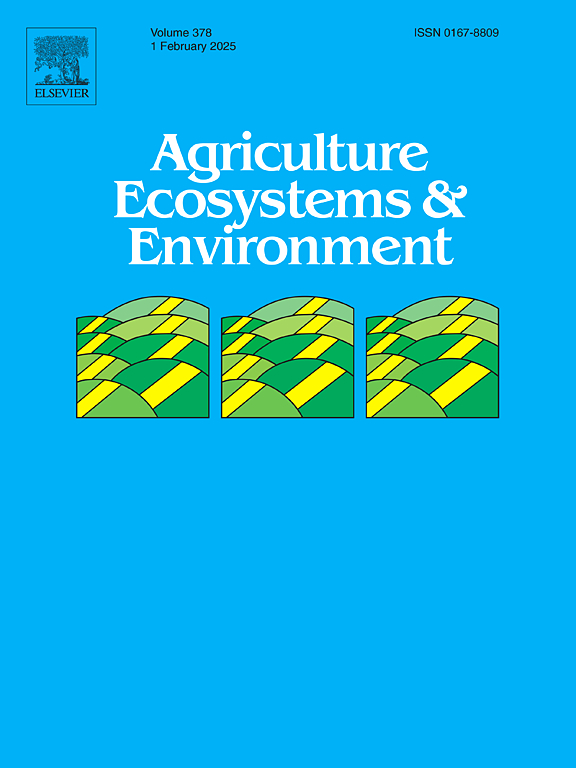长期玉米秸秆覆盖试验揭示的细菌性状对土壤有机质库积累的影响
IF 6
1区 农林科学
Q1 AGRICULTURE, MULTIDISCIPLINARY
引用次数: 0
摘要
玉米秸秆覆盖免耕能促进土壤有机质积累。土壤细菌群落对生境变化较为敏感,可影响土壤有机质池形成过程中碳(C)和氮(N)的循环,但其在长期保护性耕作下的时间调节机制尚不清楚。采用16S rRNA高通量测序技术,分析了东北地区玉米秸秆覆盖0 (M0)、6 (M6)、10 (M10)和14 (M14)年的细菌性状。与地上处理相比,M6处理的细菌表现出了更活跃的生长和代谢特征,如更高的系统发育多样性、更高的共营养/寡营养比(Copio/Oligo)、更强的物种交叉取食、更大的生物量和碳水化合物生物合成效率。类似的趋势在M10也持续存在,同时放线菌和其他物种之间的竞争更加激烈。直到M14,细菌进一步转向降低碳水化合物生物合成的效率。相应的,在M10和M14处理下,SOM分别增加了42.7 %和53.6 %,同时碳氮比增加,M14处理也显示出较高的不稳定C含量。这些发现表明,SOM池的积累经历了从最初的细菌周转稳定到细菌转化驱动的加速积累,最终增加了数量和C的可用性。结构方程模型强调,由Copio/Oligo和响应C可用性变化的生长策略形成的时间耦合细菌演替驱动了SOM质量的变化。我们的研究结果表明,细菌性状可以有效地扩大规模,以了解长期玉米秸秆覆盖下SOM的积累。本文章由计算机程序翻译,如有差异,请以英文原文为准。
How bacterial traits scale to soil organic matter pool buildup revealed by long-term maize straw mulching experiment
No-till with maize straw mulching can enhance soil organic matter (SOM) accumulation. Soil bacterial communities, which are sensitive to habitat changes, can influence carbon (C) and nitrogen (N) cycling during SOM pool buildup, yet their temporal mediation under long-term conservation tillage remains unclear. We used 16S rRNA high-throughput sequencing to analyze bacterial traits across four maize straw mulching durations, 0 (M0), 6 (M6), 10 (M10), and 14 (M14) years in Northeast China. Compared with aboveground removal, bacteria at M6 exhibited traits of active growth and metabolism, such as higher phylogenetic diversity, increased copiotroph to oligotroph ratio (Copio/Oligo), enhanced species cross-feeding, and greater potential for biomass and carbohydrate biosynthesis efficiency. Similar trends persisted at M10, accompanied by stronger competition between Actinobacteria and other species. Till M14, bacteria further shifted toward reduced efficiency in carbohydrate biosynthesis. Correspondingly, SOM increased by 42.7 % at M10 and by 53.6 % at M14, accompanied by an increased C to N ratio, with M14 also showing higher labile C content. Such findings indicated that SOM pool buildup evolved from initial stability via bacterial turnover, to accelerated accumulation driven by bacterial transformation, and ultimately to enhanced both quantity and C availability. Structural equation modeling highlighted that temporally coupled bacterial succession, shaped by Copio/Oligo and growth strategies in response to shifting C availability, drove changes in SOM quality. Our findings suggest that bacterial traits can be effectively scaled up to understand SOM buildup under long-term maize straw mulching.
求助全文
通过发布文献求助,成功后即可免费获取论文全文。
去求助
来源期刊

Agriculture, Ecosystems & Environment
环境科学-环境科学
CiteScore
11.70
自引率
9.10%
发文量
392
审稿时长
26 days
期刊介绍:
Agriculture, Ecosystems and Environment publishes scientific articles dealing with the interface between agroecosystems and the natural environment, specifically how agriculture influences the environment and how changes in that environment impact agroecosystems. Preference is given to papers from experimental and observational research at the field, system or landscape level, from studies that enhance our understanding of processes using data-based biophysical modelling, and papers that bridge scientific disciplines and integrate knowledge. All papers should be placed in an international or wide comparative context.
 求助内容:
求助内容: 应助结果提醒方式:
应助结果提醒方式:


